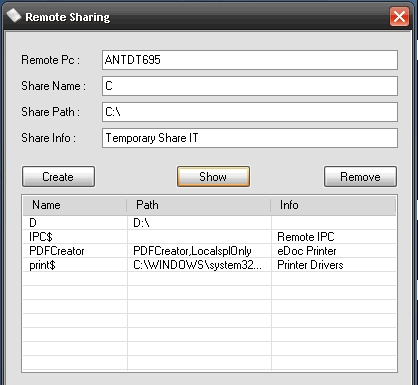Introduction
Remote Share is a simple remote sharing tool, enabling you to see, add and remove remote or local shares. The application is written in VB.NET targeting the .NET framework 2.0. The source code and the compiled programs have been included in the article.
Background
This tool has been made to facilitate creating shares on remote machines. Many times, it has been very handy, a user wants some files on this machine. You simply create a share on this machine, browse to the users' desktop and place the files right under their nose...
Using the Code
The code is pretty straight forward in using, it exists in 2 versions. A GUI version and a Console version.
The main functions are self-explanatory, one for creating a share, one for removing a share and of course a function that gives you a list of the available shares on that machine. You must be an administrator on the remote computer for the connection to be made through WMI.
For the moment, no impersonation is implemented.
Screenshots
Remote Share GUI

Remote Share Console

Main Functions
All of the functions are based on WMI methods, these methods will do the dirty work for you.
What's WMI? Windows Management Instrumentation
Using the .NET Framework namespace System.Management, you can develop applications that obtain enterprise data and automate administrative tasks using Windows Management Instrumentation (WMI). You can also develop applications that provide data to WMI classes using the WMI Provider Extensions.
For more information about WMI, please visit the MSDN website.
Create Share
This function will allow you to create a share on a local or remote machine using WMI. To execute the function below, you will have to specify the name of the share, the path, the computer name and if you like, a bit of information about the share.
The most important method in this function is of course the WMI Create Share Method. WMI Create Share Function is constructed like this:
WMIObject.Create_
(Path,Name,Type,MaximumAllowed,Description,Password,Win32_SecurityDescriptor Access)
Create Method of the Win32_Share Class
Public Sub CreateShare(ByVal strShareName As String, ByVal strPath As String,
ByVal computername As String, ByVal shareinfo As String)
Try
Dim objSWbemServices As Object
Dim objSWbemObject As Object
Dim colSWbemObject As Object
Dim intRet As Integer
Dim blnExists As Boolean
Dim objSWbem As Object
objSWbemServices = GetObject("winmgmts://" + computername + "/root/cimv2")
colSWbemObject = objSWbemServices.InstancesOf("Win32_Share")
For Each objSWbem In colSWbemObject
If (objSWbem.name = strShareName) Then
blnExists = True
Exit For
Else
blnExists = False
End If
Next
If (blnExists = False) Then
objSWbemObject = objSWbemServices.Get("Win32_Share")
intRet = objSWbemObject.Create(strPath, strShareName, 0, 25, shareinfo)
Else
MsgBox("Folder already shared")
End If
Catch ex As Exception
MsgBox("Error occurred while trying to create shares on remote pc." +
vbCrLf + "Check if you have the necessary rights and/or that" +
"the pc is turned on." + vbCrLf + ex.ToString)
End Try
End Sub
Remove Share
This function will allow you to remove shares from the machine either local or remote. Obviously the function needs 2 parameters, the name of the share and the computer name. The WMI Query (see snippet below) will collect all the shares with the name provided. Afterwards, we'll loop through these objects and simply delete them.
The method that does the deletion of the share is very simple and looks like this:
WMIObject.Delete()
Delete Method of the Win32_Share Class
Public Function RemoveShare(ByVal shareName As String,
ByVal computername As String) As Boolean
Try
Dim objSWbemServices As Object
Dim objSWbemObject As Object
Dim colSWbemObject As Object
objSWbemServices = GetObject(
"winmgmts:{impersonationLevel=impersonate}!\\" &
computername & "\root\cimv2")
colSWbemObject = objSWbemServices.ExecQuery(
"SELECT * FROM Win32_Share WHERE Name = '" + shareName + "'")
For Each objSWbemObject In colSWbemObject
objSWbemObject.Delete()
Next
Catch ex As Exception
MsgBox("Error occurred while trying to remove shares on remote pc." +
vbCrLf + "Check if you have the necessary rights and/or that the pc" +
"is turned on." + vbCrLf + ex.ToString)
End Try
End Function
Show Shares
This function requires the computer name and will make the connection to that machine. By using a WMI query that gets all instance of Win32_Share will fill the ListView on the form (if you use the GUI version):
Public Function ShowShares(ByVal ComputerName as String) As Boolean
Try
ListView1.Items.Clear()
Dim objSWbemServices As Object
Dim colSWbemObject As Object
objSWbemServices = GetObject("winmgmts://" + ComputerName + "/root/cimv2")
colSWbemObject = objSWbemServices.InstancesOf("Win32_Share")
For Each objSWbem In colSWbemObject
Dim lvitem As New ListViewItem
With lvitem
.Text = objSWbem.name
.SubItems.Add(objSWbem.path)
.SubItems.Add(objSWbem.description)
End With
ListView1.Items.Add(lvitem)
Next
Catch ex As Exception
MsgBox("Error occurred while trying to show shares on remote pc." + vbCrLf +
"Check if you have the necessary rights and/or that the pc is turned on." +
vbCrLf + ex.ToString)
End Try
End Function
Additional Links
History
- Initial version 23-06-2010
 General
General  News
News  Suggestion
Suggestion  Question
Question  Bug
Bug  Answer
Answer  Joke
Joke  Praise
Praise  Rant
Rant  Admin
Admin 









